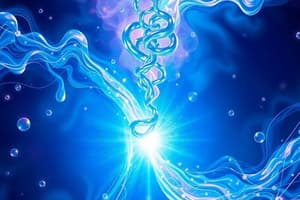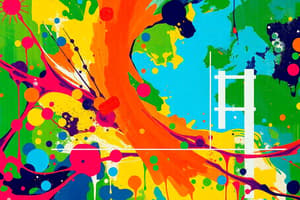Podcast
Questions and Answers
What occurs in a reversible reaction?
What occurs in a reversible reaction?
- Reactants are completely converted to products.
- Equilibrium cannot be reached.
- No reactions occur after initial products form.
- Products can convert back into reactants. (correct)
Irreversible reactions can reach a state of equilibrium.
Irreversible reactions can reach a state of equilibrium.
False (B)
What principle states that a change in conditions will shift the equilibrium to alleviate the stress?
What principle states that a change in conditions will shift the equilibrium to alleviate the stress?
Le Chatelier's Principle
An increase in temperature favors the __________ reaction.
An increase in temperature favors the __________ reaction.
When more reactant is added to a system at equilibrium, the reaction will shift:
When more reactant is added to a system at equilibrium, the reaction will shift:
Match the following effects with their results on equilibrium:
Match the following effects with their results on equilibrium:
Catalysts affect the position of equilibrium in a chemical reaction.
Catalysts affect the position of equilibrium in a chemical reaction.
What happens to the position of equilibrium if pressure is increased in a reaction involving gaseous reactants?
What happens to the position of equilibrium if pressure is increased in a reaction involving gaseous reactants?
What characterizes a reversible reaction?
What characterizes a reversible reaction?
What happens to the concentration of reactants when more product is added to a system at equilibrium?
What happens to the concentration of reactants when more product is added to a system at equilibrium?
Increasing pressure in a reaction with fewer gas moles on the product side will shift equilibrium to the __________.
Increasing pressure in a reaction with fewer gas moles on the product side will shift equilibrium to the __________.
Match the scenarios with their effects on equilibrium:
Match the scenarios with their effects on equilibrium:
Which of the following does NOT affect the position of equilibrium?
Which of the following does NOT affect the position of equilibrium?
Le Chatelier's principle states that a system at equilibrium will remain unchanged unless acted upon by an outside force.
Le Chatelier's principle states that a system at equilibrium will remain unchanged unless acted upon by an outside force.
What effect does increasing temperature have on a system at equilibrium involving an endothermic reaction?
What effect does increasing temperature have on a system at equilibrium involving an endothermic reaction?
Which statement accurately describes dynamic equilibrium?
Which statement accurately describes dynamic equilibrium?
Adding more reactants to a system in equilibrium will always cause the reaction to shift to the left.
Adding more reactants to a system in equilibrium will always cause the reaction to shift to the left.
What is indicated by a double arrow (⇌) in a chemical reaction?
What is indicated by a double arrow (⇌) in a chemical reaction?
Irreversible reactions proceed in one direction until the reactants are completely __________.
Irreversible reactions proceed in one direction until the reactants are completely __________.
Match the factors affecting equilibrium with their effects:
Match the factors affecting equilibrium with their effects:
Which factor does not change the position of equilibrium?
Which factor does not change the position of equilibrium?
Increasing the pressure in a reaction with more gaseous reactants will shift the equilibrium to the right.
Increasing the pressure in a reaction with more gaseous reactants will shift the equilibrium to the right.
In what direction does equilibrium shift when more products are added to a system?
In what direction does equilibrium shift when more products are added to a system?
Flashcards
Dynamic Equilibrium
Dynamic Equilibrium
A state where the rates of the forward and reverse reactions are equal, resulting in no net change in the concentrations of reactants and products.
Reversible Reactions
Reversible Reactions
Reactions that can proceed in both the forward and reverse directions.
Irreversible Reactions
Irreversible Reactions
Reactions that proceed in a single direction from reactants to products.
Le Chatelier's Principle
Le Chatelier's Principle
Signup and view all the flashcards
Adding Reactant
Adding Reactant
Signup and view all the flashcards
Adding Product
Adding Product
Signup and view all the flashcards
Effect of Pressure
Effect of Pressure
Signup and view all the flashcards
Effect of Temperature
Effect of Temperature
Signup and view all the flashcards
What is dynamic equilibrium?
What is dynamic equilibrium?
Signup and view all the flashcards
What are reversible reactions?
What are reversible reactions?
Signup and view all the flashcards
What are irreversible reactions?
What are irreversible reactions?
Signup and view all the flashcards
Describe Le Chatelier's Principle.
Describe Le Chatelier's Principle.
Signup and view all the flashcards
How does adding more reactant affect equilibrium?
How does adding more reactant affect equilibrium?
Signup and view all the flashcards
How does adding more product affect equilibrium?
How does adding more product affect equilibrium?
Signup and view all the flashcards
How does changing pressure affect equilibrium?
How does changing pressure affect equilibrium?
Signup and view all the flashcards
How does changing temperature affect equilibrium?
How does changing temperature affect equilibrium?
Signup and view all the flashcards
How does adding reactants or products affect equilibrium?
How does adding reactants or products affect equilibrium?
Signup and view all the flashcards
How does temperature affect equilibrium?
How does temperature affect equilibrium?
Signup and view all the flashcards
How does pressure affect equilibrium?
How does pressure affect equilibrium?
Signup and view all the flashcards
How do catalysts affect equilibrium?
How do catalysts affect equilibrium?
Signup and view all the flashcards
What is Le Chatelier's Principle?
What is Le Chatelier's Principle?
Signup and view all the flashcards
Study Notes
Dynamic Equilibrium
- Dynamic equilibrium is a state where the rates of the forward and reverse reactions are equal, resulting in no net change in the concentration of reactants or products.
- This does not mean that the forward and reverse reactions have stopped, but rather that the rates of the two processes are balanced.
- The system is constantly changing, but the observable properties remain constant.
- Dynamic equilibrium requires a closed system.
Reversible Reactions
- Reversible reactions are chemical reactions that can proceed in both the forward and reverse directions.
- A double arrow (⇌) is usually used to indicate a reversible reaction.
- Examples of reversible reactions often form an equilibrium state rather than total consumption of reactants.
Irreversible Reactions
- Irreversible reactions proceed in one direction until one or more of the reactants are completely consumed.
- There is no appreciable reverse reaction in these cases.
- The equilibrium point only exists for reversible reactions.
- A reaction that forms a very stable product can be treated effectively as irreversible.
Factors Affecting Equilibrium
-
Adding more reactant(s):
- Shifting the equilibrium position to the right, favoring the production of more products.
- This increases the rate of the forward reaction, while the reverse reaction rate remains constant.
-
Adding more product(s):
- Shifting the equilibrium position to the left, favoring the production of more reactants.
- An increase in the concentration of products will increase the rate of the reverse reaction, while the forward reaction rate remains constant.
-
Effect of Temperature:
- For an exothermic reaction, increasing the temperature will shift the equilibrium to the left, favoring the reactants.
- Increasing the temperature will favor endothermic reactions shifting equilibrium towards the products.
-
Effect of Pressure:
- Pressure changes have a large effect on equilibria involving gases.
- Increasing the pressure generally favors the reaction that produces fewer gaseous molecules, causing a shift to reduce the pressure.
- Decreasing the pressure generally favors the reaction that produces more gaseous molecules.
-
Effect of Catalysts:
- Catalysts increase the rates of both the forward and reverse reactions equally.
- Catalysts do not change the position of the equilibrium or the amount of products formed at a given temperature.
- Catalysts help reach equilibrium faster, but don't effect the amounts of products/reactants. This is essential in industries where quick reactions are important.
-
Effect of Concentrations:
- Changes in the concentration of reactants or products will disturb the equilibrium.
- The system will respond to minimize the stress by shifting the position of equilibrium.
Le Chatelier's Principle
- Le Chatelier's principle states that if a change is imposed on a system at equilibrium, the system will shift in a way that relieves the stress caused by the change.
- The stress can involve changes in concentration, pressure, or temperature, for example.
Studying That Suits You
Use AI to generate personalized quizzes and flashcards to suit your learning preferences.




